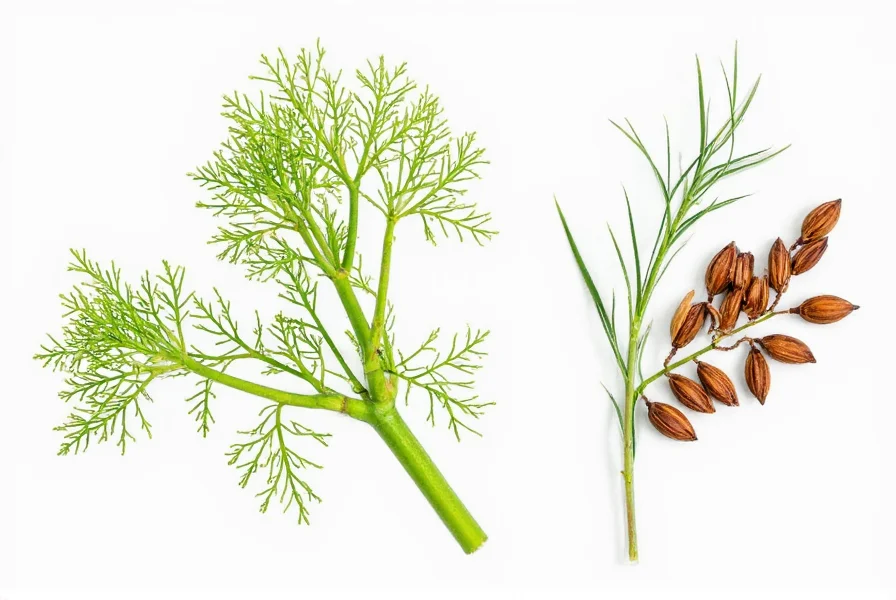Fennel seeds (Foeniculum vulgare) originate from a flowering plant in the carrot family, while anise seeds (Pimpinella anisum) come from a plant in the parsley family. This fundamental botanical distinction explains why these two spices, despite their superficial similarities, behave differently in culinary applications and offer unique flavor profiles.
Visual Differences Between Fennel and Anise Seeds
Telling fennel seeds apart from anise seeds requires close examination. Fennel seeds are larger, measuring about 4-8 mm in length, with a greenish-brown color and a slightly curved, oblong shape that resembles small carrots. They have prominent ridges running along their length.
In contrast, anise seeds are smaller (around 3-5 mm), more oval-shaped, and have a grayish-brown hue. They feature a single prominent ridge down the center rather than multiple ridges. When placed side by side, the size difference becomes immediately apparent—a key visual identifier for the difference between fennel seeds and anise seeds.
| Characteristic | Fennel Seeds | Anise Seeds |
|---|---|---|
| Botanical Name | Foeniculum vulgare | Pimpinella anisum |
| Size | 4-8 mm (larger) | 3-5 mm (smaller) |
| Color | Greenish-brown | Grayish-brown |
| Shape | Oblong, slightly curved | More oval, straighter |
| Ridges | Multiple prominent ridges | Single central ridge |
Flavor Profile Comparison
When exploring what does fennel seed taste like compared to anise, the most notable similarity is their shared licorice-like quality. However, fennel seeds offer a milder, sweeter, and more herbaceous flavor with subtle notes of citrus and grass. The taste is complex but gentle, making fennel seeds versatile in both sweet and savory applications.
Anise seeds deliver a much more intense, concentrated licorice flavor with pronounced sweetness and a sharper, almost medicinal quality when used in excess. This intensity means anise seeds require more careful measurement in recipes. Understanding this fennel seed anise seed flavor comparison helps prevent flavor imbalances in your cooking.
Culinary Applications and Substitution Guide
The culinary uses of fennel seeds and anise seeds differ significantly due to their flavor intensities and cultural associations. Fennel seeds feature prominently in Mediterranean, Indian, and Middle Eastern cuisines. Chefs use them in sausage making, breads, fish dishes, and vegetable preparations. The whole seeds work well in slow-cooked dishes where their flavor can gradually infuse the food.
Anise seeds appear more frequently in Middle Eastern, Mexican, and Eastern European cooking. They're essential in recipes like ouzo, anisette, and certain cookies and pastries. When considering can I substitute fennel seeds for anise seeds, the answer depends on the recipe:
- Substituting fennel for anise: Use 1.5-2 times the amount of fennel seeds to achieve similar licorice intensity
- Substituting anise for fennel: Use only half the amount to prevent overpowering the dish
For the most authentic results, however, following the specific spice called for in recipes yields the best flavor development.

Health Properties and Storage Recommendations
Both spices offer potential health benefits, though their properties differ. Fennel seeds contain compounds that may aid digestion and reduce bloating, which explains their traditional use as a post-meal digestive in many cultures. They also provide fiber, potassium, and some antioxidants.
Anise seeds have been studied for potential respiratory benefits and may help with coughs and congestion. They also contain antioxidants and have mild estrogenic properties that some cultures have traditionally used to support lactation.
Proper storage maintains the potency of both spices. Store them in airtight containers away from light and heat. Fennel seeds retain freshness for about 2 years, while anise seeds maintain optimal flavor for 18-24 months. For the longest shelf life, consider storing them in the freezer.

Common Misconceptions Clarified
Many people confuse fennel seeds with anise seeds because of their similar flavor profiles and occasional interchangeable use in certain recipes. However, they are not the same plant, which addresses the common question: are fennel and anise the same plant? The answer is definitively no—they belong to different botanical families with distinct growing requirements and physical characteristics.
Star anise (Illicium verum) adds further confusion to this discussion as it's a completely different spice (the star-shaped fruit of a tree native to China) that also delivers a strong licorice flavor. While star anise shares more flavor intensity with anise seeds than fennel does, it's yet another distinct botanical entity.
Frequently Asked Questions
Can I use fennel seeds instead of anise seeds in baking?
Yes, but with adjustments. Fennel seeds have a milder flavor than anise seeds, so you'll need to use about 1.5 times the amount called for in the recipe. Keep in mind that the final product will have a slightly different flavor profile—more herbal and less intensely licorice-like.
Which seed has a stronger licorice flavor: fennel or anise?
Anise seeds have a significantly stronger, more concentrated licorice flavor compared to fennel seeds. Anise delivers a sharper, sweeter licorice taste that can easily dominate a dish if used in excess, while fennel offers a milder, more complex flavor with herbal and citrus notes alongside the licorice character.
How can I tell fennel and anise seeds apart visually?
Fennel seeds are larger (4-8 mm), greenish-brown, slightly curved, and have multiple ridges. Anise seeds are smaller (3-5 mm), grayish-brown, more oval-shaped, and feature a single prominent ridge down the center. When placed side by side, the size difference is immediately noticeable.
Are fennel and anise seeds interchangeable in recipes?
They can be substituted with adjustments, but aren't perfectly interchangeable. For anise-to-fennel substitution, use 1.5-2 times the amount of fennel. For fennel-to-anise, use half the amount. Some dishes, particularly traditional recipes, rely on the specific flavor profile of one seed, so substitution may alter the authentic taste.
Do fennel and anise seeds come from the same plant family?
No, fennel seeds come from Foeniculum vulgare in the Apiaceae (carrot) family, while anise seeds come from Pimpinella anisum, which is in the same family but a different genus. Despite being in the same botanical family, they are distinct plants with different growth habits and characteristics.











 浙公网安备
33010002000092号
浙公网安备
33010002000092号 浙B2-20120091-4
浙B2-20120091-4